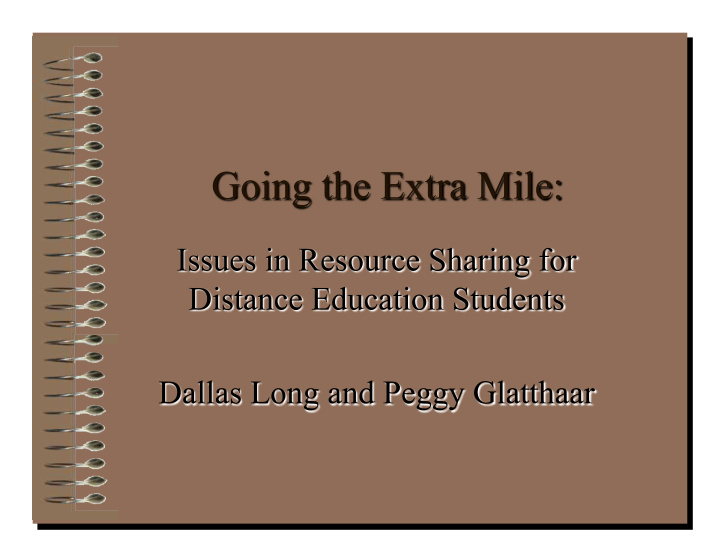



Three Kinds of Distance Ed Students • Distance Ed Students formally enrolled in entirely online programs • “Hybrid” students – primarily taking on campus classes but one or more online classes • Dissertating students – no longer on campus but still have library needs
Distance Education Students • May be located an hour away from your library or in another state entirely • Generally older than the traditional college student • More likely to be working full-time • Use many online resources but still need print materials
• Personal correspondence and tracking of requests • Distance Education Services Librarian • Notes in the callslip request • Specific patron type in Voyager
• Where is the student located geographically? • Know your local policies and applicable laws • How far is “not far enough?” • Is the student at an extension site?
Contractual Borrowing • Contract to allow access to print collection at another institution’s library • Works well for students concentrated in one area, such as extension site • Not efficient if students are geographically scattered or there is no sustained contact with contract institution
What If You Don’t Ship Materials… • Help the student identify the nearest I- Share Library as a pick-up location • Electronic document delivery for print- only journal articles • Local public library for ILL items • Proxy Patrons
Not Shipping has Drawbacks • Not everyone lives within Illinois, or even near an I-Share library • Local public libraries are hesitant to borrow for ILL • You’re making the students go the extra mile for the same services that on-campus students receive freely and easily
Shipping & Delivery • Ship materials using USPS, DHL, FedEx, etc. • Use a service which offers a tracking number • What kind of packaging? • Who bears the costs?
Make it Fast and Convenient • Fulfilling an ILL may take longer than the “window of usefulness” • Home delivery options? • Allowing returns in US mail with library- provided envelopes? • Extended loan periods?
• Charging for interlibrary loans – adding an extra cost for distance education students? • Opaque interlibrary loan processes – why is there a difference in loan periods and renewals? • Fast, efficient service in ILL! • Videostreaming – how do we do this?
Hybrid Students • Often request delivery service because they are taking online classes • How are they recorded in Voyager? • Not really entitled to delivery services if their predominant program is on-campus
• Often have very strong needs for print materials • Hard to identify their requests as needing special treatment • Proxy patrons work best – trusted friends or subject librarians • Often bear the cost of deliveries
References • “Standards for Distance Learning Library Services.” C & RL News, Oct 09, p. 558. • http://www.ala.org/ala/mgrps/divs/acrl/ standards/guidelinesdistancelearning.cfm
Recommend
More recommend